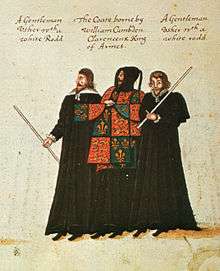Gentleman Usher
Gentleman Usher is a title for some officers of the Royal Household of the United Kingdom. See List of Gentlemen Ushers for a list of office-holders.
Gentlemen Ushers as servants
Historical

Gentlemen Ushers were originally a class of servants found not only in the Royal Household, but in lesser establishments as well. They were regularly found in the households of Tudor noblemen, and were prescribed by Richard Brathwait, in his Household of an Earle, as one of the "officers and Servants the state of an Earle requireth to have". The Gentlemen Ushers occupied a level intermediate between the steward, the usual head, and the ordinary servants; they were responsible for overseeing the work of the servants "above stairs", particularly those who cooked and waited upon the nobleman at meals, and saw to it the great chamber was kept clean by the lesser servants. He was also responsible for overseeing other miscellaneous service, such as the care of the nobleman's chapel and bed-chambers. It was traditionally the gentleman usher who swore in new members of the nobleman's service.[1]
The duties of a gentleman usher, not unlike those of a contemporary butler, made him quite important in Tudor and 17th-century households. George Chapman's play The Gentleman Usher has as its title character the pompous but easily fooled Bassiolo, Gentleman Usher to Lord Lasso.
The Gentlemen Ushers of the Royal Household, in order of precedence, were originally the four Gentlemen Ushers of the Privy Chamber (who attended the Sovereign in the Privy Chamber), the four Gentlemen Ushers Daily Waiters, and the eight Gentlemen Ushers Quarter(ly) Waiters. The latter two originally served different terms of service, but the distinction later became only nominal, as the role of the Gentlemen Ushers became increasingly ceremonial and they exercised less supervision over the staff. In 1901, King Edward VII abolished the three classes and began to appoint simply Gentlemen Ushers in Ordinary.
Contemporary
An establishment of ten Gentlemen Ushers is maintained.[2] Gentlemen Ushers to The Queen are generally appointed from retired military officers (and occasionally civilians) for irregular and infrequent attendance at royal events. When on duty they generally wear either service uniform or morning or evening dress, depending on the occasion, with a brassard, displaying the royal cypher, in addition. They act as ushers at Royal Garden Parties and Investitures, as well as on state occasions. At royal weddings, funerals and other large services they may be called upon to lead royal and other guests in procession before conducting them to their seats. Occasionally they may be called upon to attend an event (e.g. a memorial service) as the monarch's representative. Ushers, who are unpaid, retire at 70, when they may become Extra Gentlemen Ushers. They are, in some respects, the equivalent to the Military Social Aides to the US President, who attend on some 2 to 4 afternoons a month to assist visitors to the White House.
Particular Gentlemen Ushers
Certain Gentlemen Ushers have duties outside of the Royal Household, usually attached either as officers of an order of knighthood or to a House of Parliament. These are, in order of antiquity:
- The Gentleman Usher of the Black Rod, established c.1361 as an officer of the Order of the Garter, who also serves as secretary to the Lord Great Chamberlain and Doorkeeper of the House of Lords and (since 1971) Serjeant-at-Arms of the House of Lords. During the Tudor period, he was usually one of the senior members of the Royal Household, such as the Groom of the Stool; from the Restoration until 1765, Black Rod was the senior of the existing Gentleman Usher Daily Waiter, after which a new Daily Waiter was appointed to succeed the previous Black Rod. The present Black Rod is Sarah Clarke.
- The Gentleman Usher of the White Rod, established as a hereditary dignity c.1373, who attended the Parliament of Scotland before its abolition in 1707. The heritable office was pronounced to be adjudgeable in 1758, and has been bought and sold several times since then. The position was revived to some degree in connection with the Parliament of Great Britain, and is now held by the Walker Trustees.[3]
- The Gentleman Usher of the Green Rod, established 1714, is the usher for the Scottish Order of the Thistle, currently Rear Admiral Christopher Hope Layman.
- The Irish Gentleman Usher of the Black Rod, established 1783, is the usher for the Irish Order of St Patrick; there have been no appointees to the office since 1933.
- The Gentleman Usher of the Scarlet Rod, established in 1725, is the usher for the British Order of the Bath. The present Scarlet Rod is Major General James Gordon.
- The Gentleman Usher to the Sword of State, established c.1842, is the usher who bears the Sword of State in ceremonial processions, currently General Kevin O'Donoghue.
- The Gentleman Usher of the Blue Rod, established as 1882 as an "Officer of Arms" and made an usher in 1911, is the usher for the British Order of St Michael and St George, currently Dame DeAnne Julius.
- The Gentleman Usher of the Purple Rod, established in 1918, is the usher for the Order of the British Empire, currently Dame Amelia Fawcett.
Gentlemen Ushers of the Black Rod also exist for New Zealand, Australia and its states, and Canada.
References
- Jones, Paul V.B (1918). The Household of a Tudor Nobleman. University of Illinois. Retrieved 2007-08-04.
- Allison & Riddell (1991). The Royal Encyclopaedia. London: Macmillan.
- Hallen, Arthur Washington Cornelius; Stevenson, John Horne (April 1897). "The Usher of the White Rod". The Scottish Antiquary, or, Northern Notes and Queries. W. Green and Sons. XI (44): 158–170. Retrieved 2007-08-04.